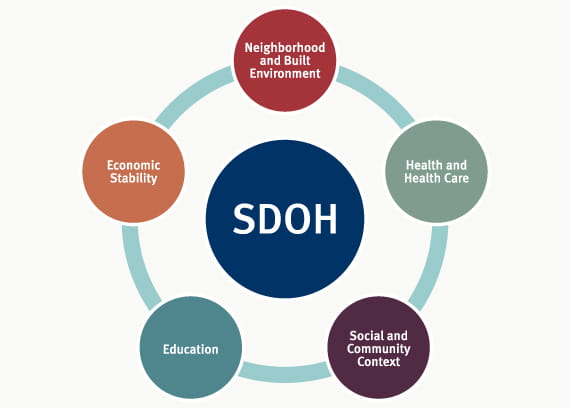Those of us in healthcare understand that the pandemic represents just one more example of the disproportionate negative impact of health issues on people of color. As stated in a 2017 National Institutes of Health report, “For racial and ethnic minorities in the United States, health disparities take on many forms, including higher rates of chronic disease and premature death compared to the rates among whites.”1
The current situation reinforces the importance of confronting racial and ethnic disparities in health status. In working to close these gaps, we can leverage the evolving focus on social determinants of health (SDoH) as the foundation of this effort.
As physicians, we were all trained in medical school on how to take a complete medical history, and that includes a social history. Unfortunately for many of us, the focus of social history was mainly on tobacco, alcohol, and drug use. Beyond that, social history emphasized identifying factors that might help lead to a diagnosis such as potential exposure to harmful substances or contagions. So, for example, we were taught that in a child with constipation and behavioral changes you might ask about housing to assess the likelihood of lead poisoning.
In that context, it’s not surprising to see healthcare providers struggling to both effectively capture SDoH information and act on the information for the benefit of their patients. However, if we are to effectively intervene to reduce health disparities, we need to utilize SDoH information not just to make a diagnosis, but to ensure that patients have the resources, knowledge, and life circumstances that enable them to manage their health. While it’s important to know if a patient is at risk for lead poisoning, it’s also critical to know if they can refrigerate their insulin reliably or if their work situation allows for them to take time for an appointment. Do they have transportation challenges or financial constraints creating barriers to care?
Providers may be hesitant to collect this information when they lack the knowledge and resources to help. Most doctor’s offices unfortunately don’t have a social worker to provide the kind of support a patient might need to address housing instability, transportation problems, or employment challenges. Community Health Clinics (CHCs) on the other hand, are better positioned to provide a model for integrating this capability. They are on the front lines of providing healthcare services to our most vulnerable populations, and close to 2/3 of their patients are comprised of racial and ethnic minorities.2 It is therefore not surprising that they’ve recognized the need for identifying and managing SDoH. The National Association of Community Health Centers has played a significant leadership role by developing the Protocol for Responding to and Assessing Patients’ Assets, Risks, and Experiences (PRAPARE). This tool enables a structured approach for capturing SDoH information and, fortunately, the PRAPARE template exists for several EHRs, including NextGen Healthcare’s platform.
The greater challenge with SDoH is identification and engagement with community-based organizations or government agencies that can help patients overcome their non-clinical challenges. There is much work to be done both within practices and across communities to facilitate connections to available resources when SDoH issues are undermining patient care. For some providers, in the midst of all of the other challenges they face, this issue feels overwhelming. But as efforts move forward to improve and integrate social services and to identify and remove cultural barriers to care, it is critical for healthcare providers to begin to systematically capture SDoH information about their patients. Healthcare disparities will not be resolved without consistent application of time, effort, and resources by everyone in the community, and healthcare providers can and should play a leadership role in this journey.
1https://www.ncbi.nlm.nih.gov/books/NBK425844/
2https://www.kff.org/report-section/a-profile-of-community-health-center-patients-demographic-characteristics/






